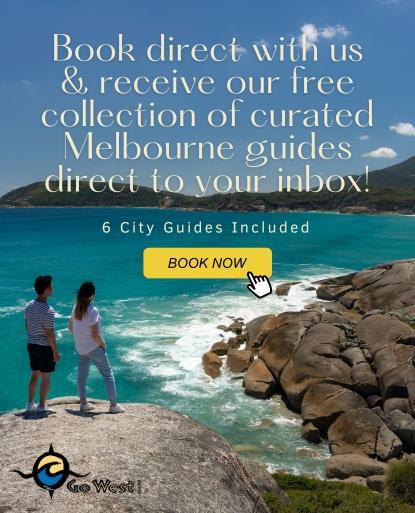You might have heard of Australia’s Little Penguins and Phillip Island Penguin Parade, but where is Phillip Island?
Phillip Island is located two hours drive from the city of Melbourne – the capital city of Victoria in the south east of Australia. It’s easily accessible on a day trip from the city. However, you’ll want to stay into the evening as the highlight of any visit to Phillip Island is the nightly Penguin Parade.
Every evening after sunset, thousands of Little Penguins emerge from the ocean and waddle across the beach to their burrows in the sand dunes. The Penguin Parade provides facilities for visitors to watch this natural spectacle without disturbing the Little Penguins or their natural environment.
If you are planning a visit to Melbourne you can take our Phillip Island Day Tour from Melbourne to enjoy this magical experience for yourself. Our tour includes a visit to the Brighton Beach bathing boxes and Moonlit Sanctuary Wildlife Conservation Park, as well as scenic stops on Phillip Island, and of course the Penguin Parade.
The history of Phillip Island
Phillip Island was inhabited by the Yalluk Bulluk clan of the Bunurong people for many thousands of years. The Bunurong people were members of the Kulin nation and their name for Phillip Island was “Millowl”.
In summertime the Yalluk Bulluk clan came to the island for food. There are several sites on Phillip Island where Aboriginal artefacts were uncovered, giving a glimpse into the lives of the Yalluk Bulluk clan. At one of their main camping sites at Forrest Caves charcoal, bone refuse, shells and other implements were unearthed. In addition, there is evidence that shows they feasted on fish, shellfish, small marsupials like wallabies and short tailed shearwaters (mutton birds).
The island’s abundant wildlife attracted European settlers and a thriving fur seal trade began in the early 1800s. The McHaffie brothers took out a lease of the island in 1842 to graze sheep. Other settlers followed when the island was opened up for lease. However conditions were very harsh on the island and many settlers left because of drought, failed crops and lack of water.
Following European settlement, the Boonwurrung/Bunurong were dispossessed and they suffered through violence and illness. In addition, sealers are believed to have taken “hundreds” of Bunurong women, causing huge disruption to the daily lives of the clans and the ceremonial and intermarriage lives of all of the Kulin Nation people. Their homelands and food sources were also massively disrupted by European settlement.
Visiting Phillip Island today
Visiting Phillip Island today is a great way to experience first hand the incredible nature and wildlife that was once a part of the lives of the Yalluk Bulluk clan. Today there is an organisation called Phillip Island Nature Parks which is in charge of 1,805 hectares of beaches, bushland and wetland reserves. Their focus is on conservation and research to protect the wildlife and natural resources on the island.
Phillip Island’s wildlife
PENGUINS
Summerland Beach is home to over 30,000 Little Penguins, and it’s also the location of the world-famous Penguin Parade. The penguins that nest on this corner of Phillip Island spend their days searching for food out at sea. Then they return to their nests in the dunes to rest of tend to their young.
The nightly parade guarantees penguin viewing. You can witness thousands of penguins waddling across the sand and to their burrows. It is a magical experience and a highlight of any visit to Phillip Island.
SEALS
Stroll the boardwalk at the Nobbies Centre to view Seal Rocks – home to Melbourne’s largest colony of Australian fur seals. These seals feed in the waters surrounding Phillip Island and therefore can be found resting and sleeping on the rocks. There are binoculars along the boardwalk which can be used to spot them out on Seal Rocks. Visiting the Nobbies Boardwalk before sunset gives you fantastic views out to the Southern Ocean and across Western Port Bay.
WHALES
Winter is the time when whales migrate from the Antarctic to the warm waters around Australia. They do this to give birth to their young in warmer waters before they travel back down south.
Humpback whales have been known to make the journey past Phillip Island and all the way to the north of Australia. Southern Right Whales make the same journey but not as far – there are a number of ‘nurseries’ along Victoria’s coastline. There have also been sightings of orcas off Phillip Island in recent years.
SHEARWATERS
Cape Woolamai is also a nesting ground for over one million short-tailed shearwaters, also known as mutton birds. Each year these migratory birds fly 8,000 kilometres from the Alaskan Aleutian Islands to Phillip Island. They can be seen on and around the island between September and April. During this time they build nests in the dunes and fly out to sea during the day to feed.
Join us on a Phillip Island Day Tour
Here’s what is included on our day tour from Melbourne:
- Visit the famous Brighton Beach boxes
- Take a guided tour of the award-winning Moonlit Sanctuary Wildlife Conservation Park
- Meet and feed a wide range of Australian animals including koalas, wombats, dingoes, and more
- Visit Point Grant on Phillip Island to view the Nobbies and Seal Rocks
- Stroll the coastal boardwalks to enjoy amazing panoramic views
- Spend the evening enjoying the magic of the Penguin Parade
So what are you waiting for? Come and join us on a Phillip Island Day Tour from Melbourne!
Written by: Leah Furey – Digital Content Coordinator @gowest.com.au


